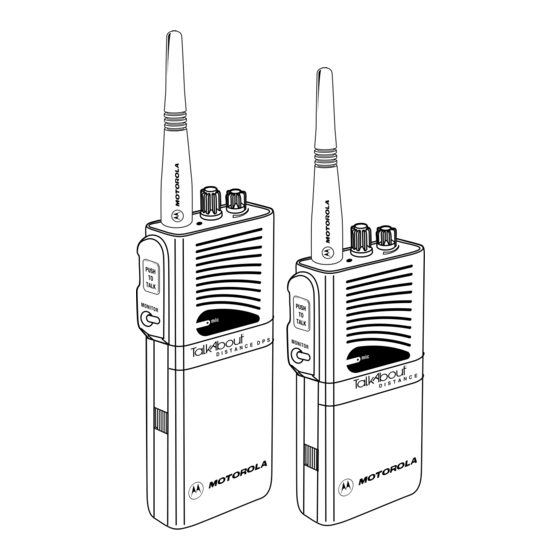Motorola DISTANCE Manual do Proprietário - Página 9
Procurar online ou descarregar pdf Manual do Proprietário para Rádio bidirecional Motorola DISTANCE. Motorola DISTANCE 10 páginas. Motorola owner's manual talkabout distance dps

Information For Safe and Efficient Operation
EXPOSURE TO RADIO FREQUENCY ENERGY
Your Motorola two-way radio, which generates and
radiates radio frequency (RF) electromagnetic
energy (EME), is designed to comply with the
following national and international standards and
guidelines regarding exposure of human beings to
radio frequency electromagnetic energy:
• FCC Report and Order FCC 96-326 (August,
1996)
• American National Standards Institute (C95-1 -
1992)
• National Council on Radiation Protection and
Measurements (NCRP - 1986)
• International Commission on Non-Ionizing Radi-
ation Protection (ICNRP - 1986)
• European Committee for Electrotechnical
Standardization (CENELEC)
- Env. 50166 - 1 1995E - Human Exposure to
Electromagnetic Fields Low Frequency (0Hz to
10kHz)
- Env. 50166 - 2 1995E - Human Exposure to
Electromagnetic
Fields
High
Frequency
(10kHz to 300Ghz)
- Proceeding of SC211/8 1996 - Safety Consid-
erations for Human Exposure to E.M.F's from
Mobile
Telecommunications
Equipment
(M.T.E.) in the Frequency Range 30MHz -
6GHz (E.M.F.-Electromagnetic Fields)
To assure optimal radio performance and that
human exposure to radio frequency electromag-
netic energy is within the guidelines set forth in the
above standards, always adhere to the following
procedures:
FOR PORTABLE TWO-WAY RADIOS
• When transmitting with a portable radio, hold
radio in a vertical position with its microphone 1
to 2 inches (2.5 to 5.0 cm) away from your
mouth. Keep antenna at least 1 inch (2.5 cm)
from your head and body.
• If you wear a portable radio on your body,
ensure that the antenna is at least one inch(2.5
cm) from your body when transmitting.
14
ELECTROMAGNETIC INTERFERENCE/
COMPATIBILITY
Nearly every electronic device is susceptible to
electromagnetic interference (EMI) if inade-
quately shielded, designed or otherwise config-
ured for electromagnetic compatibility.
• To avoid electromagnetic interference and/or
compatibility conflicts, turn off your radio in
any facility where posted notices instruct you
to do so. Hospitals or health care facilities may
be using equipment that is sensitive to exter-
nal RF energy.
• When instructed to do so, turn off your radio
when on board an aircraft. Any use of a radio
must be in accordance with airline regulations
or crew instructions.
!
WARNING
For Vehicles With an Air Bag
Do not place a portable radio in the area over an air
bag or in the air bag deployment area. Air bags
inflate with great force. If a portable radio is placed
in the air bag deployment area and the air bag
inflates, the radio may be propelled with great
force and cause serious injury to occupants of vehi-
cle.
Potentially Explosive Atmospheres
Turn your radio OFF when in any area with a poten-
tially explosive atmosphere, unless it is a type
especially qualified for such use (for example, Fac-
tory Mutual Approved). Sparks in such areas could
cause an explosion or fire resulting in bodily injury
or even death.
Batteries
Do not replace or charge batteries in a potentially
explosive atmosphere. Contact sparking may occur
while installing or removing batteries and cause an
explosion.
Blasting Caps and Areas
To avoid possible interference with blasting opera-
tions, turn your radio OFF near electrical blasting
caps or in a "blasting area" or in areas posted: "Turn
off two-way radio". Obey all signs and instructions.
Note : Areas with potentially explosive atmo-
spheres are often, but not always, clearly marked.
They include fuelling areas such as below deck on
boats, fuel or chemical transfer or storage facili-
ties; areas where the air contains chemicals or par-
ticles, such as grain, dust, or metal powders; and
any other area where you would normally be
advised to turn off your vehicle engine.
!
CAUTION
Damaged Antennas
Do not use any radio that has a damaged antenna.
If a damaged antenna comes in contact with the
skin, a minor burn may result.
Batteries
All batteries can cause property damage and/or
bodily injury such as burns if a conductive material
such as jewelry, keys or beaded chains touches
exposed terminals. The material may complete an
electrical circuit (short circuit) and become quite
hot. Exercise care in handling any charged battery,
particularly when placing it inside a pocket, purse or
other container with metal objects.
15
